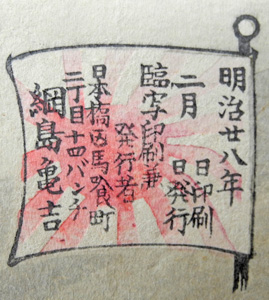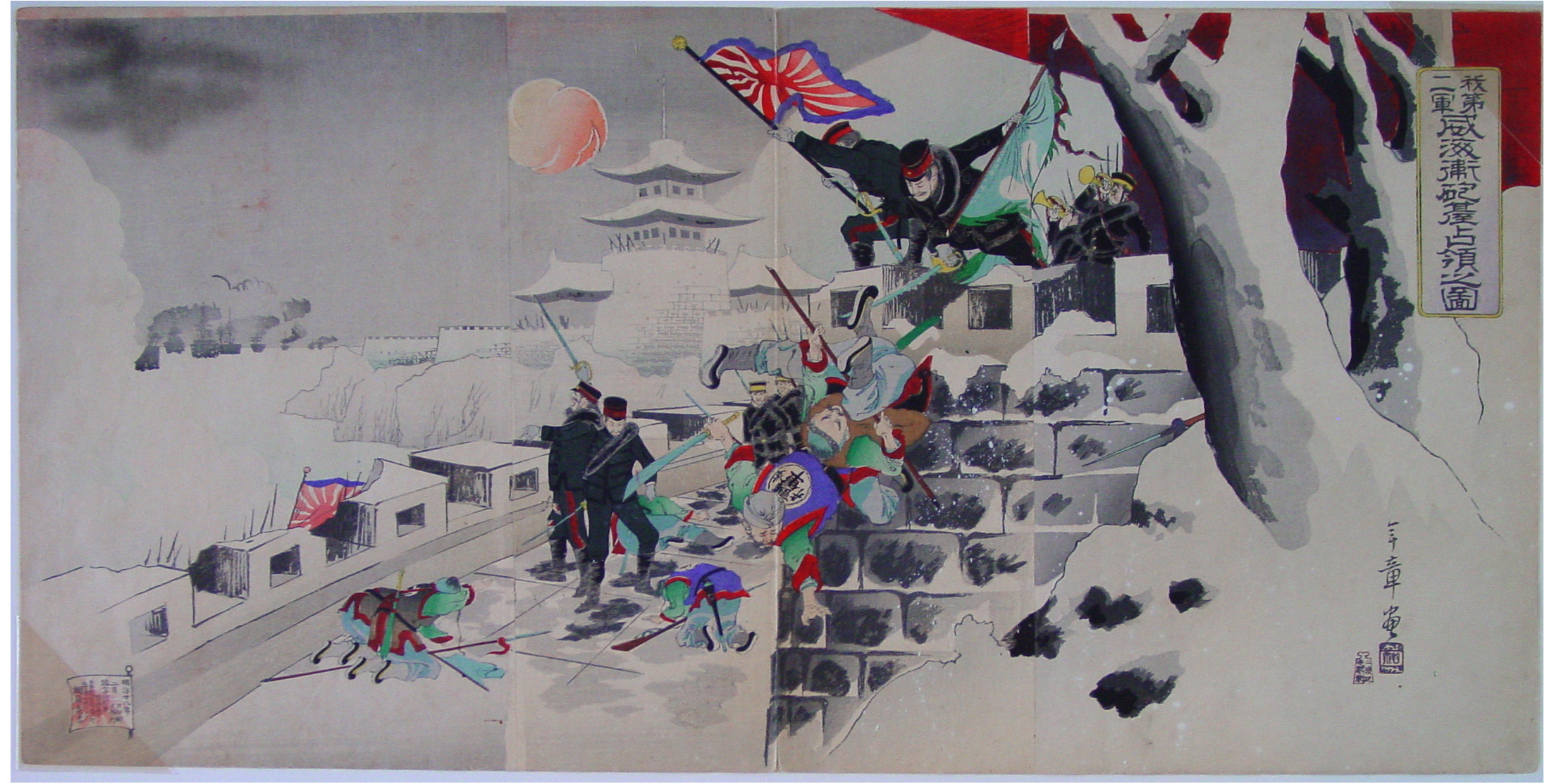About This Print
The Campaign at Wei-Hai-Wei
Source: The Sino-Japanese War, Nathan Chaikin, self-published, 1983, p. 104
The Wei-Hai-Wei campaign was very short. The first men landed on January 20, and on February 16 they were in possession of all forts and ships. It was the most dramatic episode of the war, and nothing was wanting to enhance its spectacular effect. The hills encircling the bay formed a gigantic amphitheater from which the vicissitudes of the struggle could be observed. Military attaches and men-of-war of the principal navies of the world followed with intense curiosity all the operations, and the Japanese, conscious that they were acting before a gallery of nations, determined to display, day after day, all the resources of their skill and daring. In a few days the Japanese exhibited all the methods of modern warfare by land and ships, daring torpedo attacks which strewed the harbor with sunken hulls. The Japanese never relaxed their relentless hold on the foredoomed fleet until the inevitable surrender came.
Source: LoveToKnow Classic Encyclopedia project website http://25.1911encyclopedia.org/C/CH/CHINO_JAPANESE_WAR.htm
The 2nd army, still under Oyama, had undertaken operations against Wei-hai-wei, the second great fortress and dockyard of northern China, where Admiral Ting's squadron had been refitting since the battle of the Yalii; and it was hoped that both armies would accomplish their present tasks in time to advance in the summer against Peking itself. On the 18th of January a naval demonstration was made at Teng-chow-fu, 70 in. west of Wei-hai-wei, and on the eighth the Japanese began their disembarkation at Yung-cheng Bay, about 12 m. from Wei-hai-wei. The landing was scarcely opposed, and on the 26th the Japanese advance was begun. The south-eastern defenses of Wei-hai-wei harbor were carried by the 6th division, whilst the 2nd division reached the inner waters of the bay, driving the Chinese before them. The fleet under Ito co-operated effectively. On the night of the 4th-5th of February the Chinese squadron in harbor was attacked by ten torpedo boats. Two boats were lost, but the armor-clad "Ting-Yuen" was sunk. On the following night a second attack was made, and three more vessels were sunk. On the 9th the "Ching-Yuen" was sunk by the guns in one of the captured forts. On the 12th Admiral Ting wrote to Admiral Ito offering to surrender, and then took poison, other officers following his example. Wei-hai-wei was then dismantled by the Japanese, who recovered the remnant of the Chinese squadron, including the "Chen Yuen," [Chinen] and the 2nd army concentrated at Port Arthur for the advance on Peking.
The Wei-Hai-Wei campaign was very short. The first men landed on January 20, and on February 16 they were in possession of all forts and ships. It was the most dramatic episode of the war, and nothing was wanting to enhance its spectacular effect. The hills encircling the bay formed a gigantic amphitheater from which the vicissitudes of the struggle could be observed. Military attaches and men-of-war of the principal navies of the world followed with intense curiosity all the operations, and the Japanese, conscious that they were acting before a gallery of nations, determined to display, day after day, all the resources of their skill and daring. In a few days the Japanese exhibited all the methods of modern warfare by land and ships, daring torpedo attacks which strewed the harbor with sunken hulls. The Japanese never relaxed their relentless hold on the foredoomed fleet until the inevitable surrender came.
Source: LoveToKnow Classic Encyclopedia project website http://25.1911encyclopedia.org/C/CH/CHINO_JAPANESE_WAR.htm
The 2nd army, still under Oyama, had undertaken operations against Wei-hai-wei, the second great fortress and dockyard of northern China, where Admiral Ting's squadron had been refitting since the battle of the Yalii; and it was hoped that both armies would accomplish their present tasks in time to advance in the summer against Peking itself. On the 18th of January a naval demonstration was made at Teng-chow-fu, 70 in. west of Wei-hai-wei, and on the eighth the Japanese began their disembarkation at Yung-cheng Bay, about 12 m. from Wei-hai-wei. The landing was scarcely opposed, and on the 26th the Japanese advance was begun. The south-eastern defenses of Wei-hai-wei harbor were carried by the 6th division, whilst the 2nd division reached the inner waters of the bay, driving the Chinese before them. The fleet under Ito co-operated effectively. On the night of the 4th-5th of February the Chinese squadron in harbor was attacked by ten torpedo boats. Two boats were lost, but the armor-clad "Ting-Yuen" was sunk. On the following night a second attack was made, and three more vessels were sunk. On the 9th the "Ching-Yuen" was sunk by the guns in one of the captured forts. On the 12th Admiral Ting wrote to Admiral Ito offering to surrender, and then took poison, other officers following his example. Wei-hai-wei was then dismantled by the Japanese, who recovered the remnant of the Chinese squadron, including the "Chen Yuen," [Chinen] and the 2nd army concentrated at Port Arthur for the advance on Peking.
Print Details
| IHL Catalog | #91 |
| Title or Description | Illustration of the Occupation of the Hodai Fort, at Wei-Hai-Wei by our 2nd Army Waga dainigun Ikaiei hōdai senryō no zu 我第二軍威海衛砲臺占領之圖 |
| Artist | Yūsai Toshiaki (1864-1921) |
| Signature |  |
| Seal | Yūsai 幽斎[see above] |
| Publication Date | February 1895 (Meiji 28) |
| Publisher |  seal of the publisher Tsujiokaya Kamekichi 辻岡屋亀吉 [Marks: pub. ref. 549; seal not shown] |
| Carver |  |
| Printer | |
| Impression | excellent |
| Colors | excellent - with application of gofun for snow effect. |
| Condition | good - trimmed into the image, backed, panels joined, center fold center panel (slight separation at edges), minor color offsetting |
| Genre | ukiyo-e; senso-e (Sino-Japanese War) |
| Miscellaneous | |
| Format | vertical oban triptych |
| H x W Paper | 14 x 27 7/8 in. (35.6 x 70.8 cm) |
| H x W Image | |
| Literature | The Sino-Japanese War, Nathan Chaikin, self-published, 1983, p. 201 |
| Collections This Print | Museum of Fine Arts, Boston 2000.256a-c |
4/28/2020


